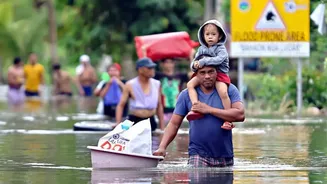Typhoon's Approach
Super Typhoon Fung-wong presented a significant threat to the Philippines, prompting widespread evacuation measures. The powerful storm was expected to bring
torrential rains and destructive winds, endangering the lives and safety of those in its path. In response to the impending danger, authorities initiated the evacuation of approximately 100,000 residents from vulnerable areas. This large-scale operation aimed to move people from high-risk locations to safer grounds, such as evacuation centers, where they could receive essential assistance and protection from the storm's impact. The storm’s projected path and intensity necessitated immediate and extensive action to mitigate potential casualties and damage.
Massive Evacuation Begins
The evacuation of 100,000 residents was a crucial step in preparing for Super Typhoon Fung-wong. The evacuation involved transporting individuals from areas deemed most at risk from the approaching storm. Many evacuees were moved to government-designated evacuation centers, which offered shelter, food, and medical assistance. This preemptive measure was designed to reduce the risk of injury and fatalities caused by the typhoon's powerful winds, heavy rainfall, and potential flooding. The coordinated effort involved various agencies and organizations, working together to ensure the safe and orderly relocation of affected populations. This strategic move underscored the government's commitment to prioritizing the safety and well-being of its citizens in the face of a severe weather event.
Expected Storm Impact
Super Typhoon Fung-wong posed a significant threat with its potential to cause severe damage. The primary concerns included torrential rainfall, which could lead to flooding, landslides, and infrastructure damage. The storm was also expected to generate destructive winds capable of uprooting trees, damaging buildings, and disrupting essential services like power and communication networks. The combined impact of heavy rainfall and powerful winds could have far-reaching consequences, affecting both urban and rural areas. Local authorities prepared for potential disruptions to daily life and were on standby to provide emergency assistance. The impending arrival of the super typhoon required that residents heed warnings and take all necessary precautions to protect themselves and their property.
Safety and Preparedness
With Super Typhoon Fung-wong approaching, the focus shifted to safety and preparedness. The government and various agencies were engaged in a multifaceted approach to protect residents. This included issuing timely weather warnings, advising people on safety measures, and coordinating emergency response teams. Authorities ensured that evacuation centers were adequately equipped with essential supplies, such as food, water, and medical resources. People were urged to secure their homes, monitor weather updates, and be ready to evacuate if necessary. Local communities were encouraged to look out for each other, providing assistance to those who were more vulnerable. Overall, the emphasis was on a proactive and unified response to mitigate the potential impact of the super typhoon.
















